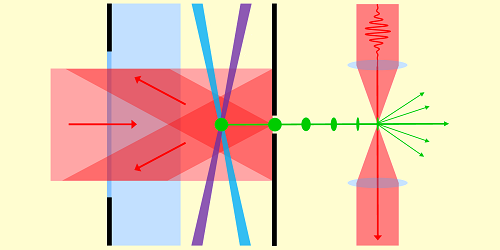Electron Bunches Break the Picosecond Barrier
Imaging techniques such as ultrafast electron diffraction and ultrafast electron microscopy use short electron bunches to probe the dynamics of atoms inside materials. The resolution of these methods could be boosted by using bunches that are ultracold and of subpicosecond duration, but scientists have struggled to make bunches with both of those properties. A new method from Tim de Raadt and his colleagues at Eindhoven University of Technology in the Netherlands changes the status quo [1]. The researchers say that their approach might help enable single-shot imaging of protein structures at the atomic level.
In the team’s technique, a cloud of cold rubidium atoms is formed in a structure called a magneto-optical trap at a region where four laser beams overlap. These atoms are excited and ionized using two additional laser beams. This so-called photoionization process releases electrons with temperatures of about 20 K that are accelerated through a small hole in a wall of the trap to produce electron bunches. The duration of these ultracold bunches decreases with increasing distance from the hole and is minimal at a location known as the self-compression point.
De Raadt and his colleagues analyzed the properties of the bunches at the self-compression point. They measured bunch durations as short as 0.735 ps—2 orders of magnitude shorter than the previous best of 25 ps. By comparing the observed temporal structure of the bunches to simulations of the photoionization process, they predict that the minimum bunch duration is set by the photoionization timescale. The researchers suggest that an adjusted setup could facilitate electron bunches that, compared to this demonstration, have even lower temperature and therefore even better resolution for ultrafast diffraction and microscopy.
–Ryan Wilkinson
Ryan Wilkinson is a Corresponding Editor for Physics Magazine based in Durham, UK.
References
- T. C. H. de Raadt et al., “Subpicosecond ultracold electron source,” Phys. Rev. Lett. 130, 205001 (2023).




